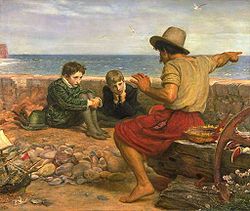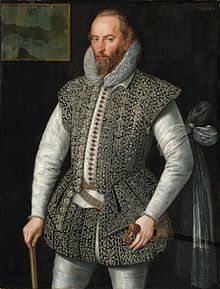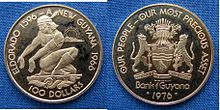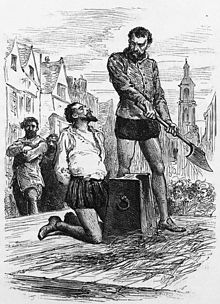Poems by this Poet
Pagination
Sir Walter Raleigh (/ˈrɔːli/, /ˈræli/, or /ˈrɑːli/;[2] circa 1554 – 29 October 1618) was an English landed gentleman, writer, poet, soldier, politician, courtier, spy, and explorer. He was cousin to Sir Richard Grenville and younger half-brother of Sir Humphrey Gilbert. He is also well known for popularising tobacco in England.
Raleigh was born to a Protestant family in Devon, the son of Walter Raleigh and Catherine Champernowne. Little is known of his early life, though he spent some time in Ireland, in Killua Castle, Clonmellon, County Westmeath, taking part in the suppression of rebellions and participating in the Siege of Smerwick. Later, he became a landlord of property confiscated from the native Irish. He rose rapidly in the favour of Queen Elizabeth I and was knighted in 1585. Instrumental in the English colonisation of North America, Raleigh was granted a royal patent to explore Virginia, which paved the way for future English settlements. In 1591, he secretly married Elizabeth Throckmorton, one of the Queen's ladies-in-waiting, without the Queen's permission, for which he and his wife were sent to the Tower of London. After his release, they retired to his estate at Sherborne, Dorset.
In 1594, Raleigh heard of a "City of Gold" in South America and sailed to find it, publishing an exaggerated account of his experiences in a book that contributed to the legend of "El Dorado". After Queen Elizabeth died in 1603, Raleigh was again imprisoned in the Tower, this time for being involved in the Main Plot against King James I, who was not favourably disposed toward him. In 1616, he was released to lead a second expedition in search of El Dorado. This was unsuccessful, and men under his command ransacked a Spanish outpost. He returned to England and, to appease the Spanish, was arrested and executed in 1618.
Raleigh was one of the most notable figures of the Elizabethan era. In 2002, he featured in the BBC poll of the 100 Greatest Britons.[3]
Contents
Early life
Little is known about Raleigh's birth.[4] Some historians believe he was born on 22 January 1552, although the Oxford Dictionary of National Biography currently favours a date of 1554.[5] He grew up in the house of Hayes Barton,[6] a farmhouse near the village of East Budleigh, not far from Budleigh Salterton, in Devon. He was the youngest of five sons born to Catherine Champernowne in two successive marriages. His half-brothers, John Gilbert, Humphrey Gilbert, Adrian Gilbert and full brother Carew Raleigh were also prominent during the reigns of Elizabeth I and James I. Catherine Champernowne was a niece of Kat Ashley, Elizabeth's governess, who introduced the young men at court.[7]
Raleigh's family was highly Protestant in religious orientation and had a number of near escapes during the reign of the Roman Catholic Queen Mary I of England. In the most notable of these, his father had to hide in a tower to avoid execution. As a result, during his childhood, Raleigh developed a hatred of Roman Catholicism and proved himself quick to express it after the Protestant Queen Elizabeth I came to the throne in 1558. In matters of religion, Elizabeth was more moderate than her sister Mary.
In 1569, Raleigh left for France to serve with the Huguenots in the French religious civil wars.[4] In 1572, Raleigh was registered as an undergraduate at Oriel College, Oxford, but he left a year later without a degree. Raleigh proceeded to finish his education in the Inns of Court.[4] In 1575, he was registered at the Middle Temple. At his trial in 1603, he stated he had never studied law. His life between these two dates is uncertain, but in his History of the World, he claimed to be an eye witness at the Battle of Moncontour (3 October 1569) in France. In 1575 or 1576, Raleigh returned to England.[8]
Ireland
Between 1579 and 1583, Raleigh took part in the suppression of the Desmond Rebellions. He was present at the Siege of Smerwick.[9] Upon the seizure and distribution of land following the attainders arising from the rebellion, Raleigh received 40,000 acres (160 km2), including the coastal walled towns of Youghal and Lismore. This made him one of the principal landowners in Munster, but he enjoyed limited success in inducing English tenants to settle on his estates.
During his 17 years as an Irish landlord, frequently being domiciled at Killua Castle, Clonmellon, County Westmeath, Raleigh made the town of Youghal his occasional home. He was mayor there from 1588 to 1589. His town mansion, Myrtle Grove, is assumed to be the setting for the story that his servant doused him with a bucket of water after seeing clouds of smoke coming from Raleigh's pipe, in the belief he had been set alight. But this story is also told of other places associated with Raleigh: the Virginia Ash Inn in Henstridge near Sherborne, Sherborne Castle and South Wraxall Manor in Wiltshire, home of Raleigh's friend, Sir Walter Long.
Amongst Raleigh's acquaintances in Munster was another Englishman who had been granted land there, the poet Edmund Spenser. In the 1590s, he and Raleigh travelled together from Ireland to the court at London, where Spenser presented part of his allegorical poem, the Faerie Queene, to Elizabeth I.
Raleigh's management of his Irish estates ran into difficulties, which contributed to a decline in his fortunes. In 1602, he sold the lands to Richard Boyle, 1st Earl of Cork, who subsequently prospered under kings James I and Charles I.[11] Following Raleigh's death, members of his family approached Boyle for compensation on the ground that Raleigh had struck an improvident bargain.
The New World
Raleigh's charter explored from North Carolina to Florida and named the region 'Virginia' in honor of the "Virgin Queen".[12]
Raleigh's plan in 1584 for colonisation in the "Colony and Dominion of Virginia" in North America ended in failure at Roanoke Island, but paved the way for subsequent colonies.[13] These expeditions were funded primarily by Raleigh and his friends, but never provided the steady stream of revenue necessary to maintain a colony in America. (Subsequent colonisation attempts in the early 17th century were made under the joint-stock Virginia Company, which was able to raise the capital necessary to create successful colonies.)
In 1587, Raleigh attempted a second expedition, again establishing a settlement on Roanoke Island. This time, a more diverse group of settlers was sent, including some entire families, under the governance of John White.[14] After a short while in America, White returned to England to obtain more supplies for the colony, planning to return in a year. Unfortunately for the colonists at Roanoke, one year became three. The first delay came when Queen Elizabeth I ordered all vessels to remain at port for potential use against the Spanish Armada. After England's 1588 victory over the Spanish Armada, the ships were given permission to sail.[15]:125–126
The second delay came after White's small fleet set sail for Roanoke and his crew insisted on sailing first towards Cuba in hopes of capturing treasure-laden Spanish merchant ships. Enormous riches described by their pilot, an experienced Portuguese navigator hired by Raleigh, outweighed White's objections to the delay.[15]:125–126
When the supply ship arrived in Roanoke, three years later than planned, the colonists had disappeared.[15]:130–33 The only clue to their fate was the word "CROATOAN" and letters "CRO" carved into tree trunks. White had arranged with the settlers that if they should move, the name of their destination be carved into a tree or corner post. This suggested the possibilities that they had moved to Croatoan Island, but a hurricane prevented John White from investigating the island for survivors.[15]:130–33 Other speculation includes their having starved, or been swept away or lost at sea during the stormy weather of 1588. No further attempts at contact were recorded for some years. Whatever the fate of the settlers, the settlement is now remembered as the "Lost Colony of Roanoke Island".
Later life
1580s
In December 1581, Raleigh returned to England from Ireland to despatches as his company had been disbanded. He took part in court life and because of his efforts in increasing the Protestant Church in Ireland,[12] he became a favourite of Queen Elizabeth I. In 1585, Raleigh was knighted and was appointed warden of the stannaries, that is of the tin mines of Cornwall and Devon, Lord Lieutenant of Cornwall, and vice-admiral of the two counties. Both in 1585 and 1586, he sat in parliament as member for Devonshire.[16] He was also granted the right to colonize America.[12]
Raleigh commissioned the shipbuilder R. Chapman, of Deptford to build a ship for him. Originally called Ark, it became Ark Raleigh, following the convention at the time by which the ship bore the name of its owner. The Crown, in the form of Queen Elizabeth I, purchased the ship from Raleigh in January 1587, for the sum of £5,000 (£1,100,000 as of 2015).[17] (This took the form of a reduction in the sum Sir Walter owed the queen: he received Exchequer tallies, but no money.) As a result, the ship was renamed Ark Royal.[18]
1590–1594
In 1592, Raleigh was given many rewards by the Queen, including Durham House in the Strand and the estate of Sherborne, Dorset. He was appointed Captain of the Yeomen of the Guard. However, he had not been given any of the great offices of state. In the Armada year of 1588, Raleigh had some involvement with defense against the Spanish at Devon. His ship, the Ark Ralegh, was Lord Admiral Howard's flagship.[19]
In 1591, Raleigh was secretly married to Elizabeth "Bess" Throckmorton (or Throgmorton). She was one of the Queen's ladies-in-waiting, 11 years his junior, and was pregnant at the time. She gave birth to a son, believed to be named Damerei, who was given to a wet nurse at Durham House, but died in October 1592 of plague. Bess resumed her duties to the queen. The following year, the unauthorised marriage was discovered and the Queen ordered Raleigh imprisoned and Bess dismissed from court. Both were imprisoned in the Tower of London in June 1592. He was released from prison in August 1592 to manage a recently-returned expedition/attack on the Spanish coast. Although recalled by the Queen, the fleet captured an incredibly rich prize, the Madre de Deus (Mother of God) off Flores of which he had to organize and divide the spoils. He was sent back to the Tower, but by early 1593 had been released and become a member of Parliament.[20]
It would be several years before Raleigh returned to favour, and Raleigh traveled extensively in this time. Raleigh and his wife remained devoted to each other. They had two more sons, Walter (known as Wat) and Carew.[21]
Raleigh was elected a burgess of Mitchell, Cornwall, in the parliament of 1593.[5] He retired to his estate at Sherborne, where he built a new house, completed in 1594, known then as Sherborne Lodge. Since extended, it is now known as Sherborne (new) Castle. He made friends with the local gentry, such as Sir Ralph Horsey of Clifton Maybank and Charles Thynne of Longleat. During this period at a dinner party at Horsey's, Raleigh had a heated discussion about religion with Reverend Ralph Ironsides. The argument later gave rise to charges of atheism against Raleigh, though the charges were dismissed. He was elected to Parliament, speaking on religious and naval matters.[22]
First voyage to Guiana
In 1594, he came into possession of a Spanish account of a great golden city at the headwaters of the Caroní River. A year later, he explored what is now Guyana and eastern Venezuela in search of Lake Parime and Manoa, the legendary city. Once back in England, he published The Discovery of Guiana,[23] (1596) an account of his voyage which made exaggerated claims as to what had been discovered. The book can be seen as a contribution to the El Dorado legend. Although Venezuela has gold deposits, no evidence indicates Raleigh found any mines. He is sometimes said to have discovered Angel Falls, but these claims are considered far-fetched.[24]
In 1596, Raleigh took part in the Capture of Cadiz, where he was wounded. He also served as the rear admiral (a principal command) of the Islands Voyage to the Azores in 1597.[26]
In 1597, he was chosen member of parliament for Dorset, and, in 1601, for Cornwall.[16] He was unique in the Elizabethan period in sitting for three counties.[5]
From 1600 to 1603, as governor of the Channel Island of Jersey, Raleigh modernised its defences. This included construction of a new fort protecting the approaches to Saint Helier, Fort Isabella Bellissima, or Elizabeth Castle.[citation needed]
Trial and imprisonment
Royal favour with Queen Elizabeth had been restored by this time, but his good fortune did not last. The Queen died March 23, 1603. Raleigh was arrested and imprisoned in the Tower of London on 19 July 1603. On 17 November, Raleigh was tried in the converted Great Hall of Winchester Castle for treason, due to his involvement in the Main Plot against King James.[27]
Raleigh conducted his defence. The chief evidence against Raleigh was the signed and sworn confession of his friend Henry Brooke, 11th Baron Cobham. Raleigh frequently requested that Cobham be called in to testify, so he might recant, "[Let] my accuser come face to face, and be deposed. Were the case but for a small copyhold, you would have witnesses or good proof to lead the jury to a verdict; and I am here for my life!" Raleigh essentially was objecting that the evidence against him was "hearsay", but the tribunal refused to allow Cobham to testify and be cross-examined.[28][29] King James spared his life, despite a guilty verdict.[citation needed] In October 1994, documents which had previously been imperfectly catalogued at the Bodleian Library were discovered during random checking of papers held there. These included Raleigh's own deposition and Cobham's statement to the tribunal, and provide strong evidence that Raleigh denounced King James and spoke in favour of a Spanish invasion, and went so far as to advise on the best invasion location (he recommended Milford Haven); he also requested a Spanish pension of £1,500 a year in return for his spying.[30]
He remained imprisoned in the Tower until 1616. While there, he wrote many treatises and the first volume of The Historie of the World (first edition published 1614)[31] about the ancient history of Greece and Rome. His son, Carew, was conceived and born (1604) while Raleigh was imprisoned in the Tower.
Second voyage to Guiana, 1617–1618
In 1616, Raleigh was released to conduct a second expedition to Venezuela in search of El Dorado. During the expedition, Raleigh's men, under the command of Lawrence Keymis, attacked the Spanish outpost of Santo Tomé de Guyana (San Tomé) on the Orinoco River in violation of peace treaties with Spain. In the initial attack on the settlement, Raleigh's son, Walter, was fatally shot. On Raleigh's return to England, an outraged Count Gondomar, the Spanish ambassador, successfully demanded that King James I reinstate Raleigh's death sentence. Raleigh was brought to London from Plymouth, by Sir Lewis Stukeley, and passed up numerous opportunities to make an effective escape.[32][33]
Execution and aftermath
Raleigh was beheaded in the Old Palace Yard at the Palace of Westminster on 29 October 1618. "Let us dispatch", he said to his executioner. "At this hour my ague comes upon me. I would not have my enemies think I quaked from fear." After he was allowed to see the axe that would behead him, he mused: "This is a sharp Medicine, but it is a Physician for all diseases and miseries." According to many biographers – for instance, Raleigh Trevelyan in Sir Walter Raleigh (2002) – Raleigh's final words (as he lay ready for the axe to fall) were: "Strike, man, strike!"[34]
Having been one of the people to popularise tobacco smoking in England, he left a small tobacco pouch, found in his cell shortly after his execution. Engraved upon the pouch was a Latin inscription: Comes meus fuit in illo miserrimo tempore ("It was my companion at that most miserable time").[35][36]
Raleigh's head was embalmed and presented to his wife. His body was to be buried in the local church in Beddington, Surrey, the home of Lady Raleigh, but was finally laid to rest in St. Margaret's, Westminster, where his tomb may still be visited today.[37] "The Lords", she wrote, "have given me his dead body, though they have denied me his life. God hold me in my wits."[38] It has been said that Lady Raleigh kept her husband's head in a velvet bag until her death.[39] After his wife's death 29 years later, Raleigh's head was returned to his tomb and interred at St. Margaret's Church.[40]
Although Raleigh's popularity had waned considerably since his Elizabethan heyday, his execution was seen by many, both at the time and since, as unnecessary and unjust, as for many years his involvement in the Main Plot seemed to have been limited to a meeting with Lord Cobham.[41] One of the judges at his trial later said: "The justice of England has never been so degraded and injured as by the condemnation of the honourable Sir Walter Raleigh."[42] This view has been less widely held since the discovery of some of the 1603 tribunal's paperwork in the Bodleian Library in 1994, which strongly supports the case against Raleigh.[30]
Poetry
Raleigh's poetry is written in the relatively straightforward, unornamented mode known as the plain style. C. S. Lewis considered Raleigh one of the era's "silver poets", a group of writers who resisted the Italian Renaissance influence of dense classical reference and elaborate poetic devices. His writing contains strong personal treatment of themes such as love, loss, beauty, and time. Most of his poems are short lyrics that were inspired by actual events.[4]
In poems such as "What is Our Life" and "The Lie", Raleigh expresses a contemptus mundi (contempt of the world) attitude more characteristic of the Middle Ages than of the dawning era of humanistic optimism. But, his lesser-known long poem "The Ocean to Cynthia" combines this vein with the more elaborate conceits associated with his contemporaries Edmund Spenser and John Donne, expressing a melancholy sense of history. The poem was written during his imprisonment in the Tower of London.[4]
Raleigh wrote a poetic response to Christopher Marlowe's "The Passionate Shepherd to His Love" of 1592, entitled "The Nymph's Reply to the Shepherd". Both were written in the style of traditional pastoral poetry and follow the structure of six four-line stanzas employing a rhyme scheme of AABB, with Raleigh's an almost line-for-line refutation of Marlowe's sentiments.[43] Years later, the 20th century poet William Carlos Williams would join the poetic "argument" with his "Raleigh was Right."
Poems by Sir Walter Raleigh (alphabetically):[44]
- The Artist
- As You Came from the Holy Land
- The Conclusion
- Epitaph
- Even Such is Time
- A Farewell to False Love
- Farewell to the Court
- From Catullus V
- Her Reply
- His Pilgrimage
- Hymn
- The Lie
- Life
- A Literature Lesson. Sir Patrick Spens in the Eighteenth Century Manner
- My Last Will
- Nature that Washed Her Hands in Milk
- Now What is Love
- The Nymph's Reply to the Shepherd
- The Ocean to Cynthia
- On Being Challenged to Write and Epigram in the Manner of Herrick
- The Passionate Man's Pilgrimage
- Prais'd be Diana's Fair and Harmless Light
- Sestina Otiosa
- The Silent Lover I
- The Silent Love II
- Sir Walter Raleigh (The night before his death)
- Sir Walter Raleigh to His Son
- Song of Myself
- Stans Puer ad Mensam
- To a Lady with an Unruly and Ill-mannered Dog Who Bit several Persons of Importance
- To His Love When He Had Obtained Her
- A Vision upon the Fairy Queen
- What is Our Life
Legacy
A galliard was composed in honour of Raleigh by either Francis Cutting or Richard Allison.[45]
The state capital of North Carolina, its second-largest city, was named Raleigh in 1792 after Sir Walter, sponsor of the Roanoke Colony. In the city, a bronze statue, which has been moved around different locations within the city, was cast in honor of the city's namesake. The "Lost Colony" is commemorated at the Fort Raleigh National Historic Site on Roanoke Island, North Carolina.[citation needed]
One of 11 boarding houses at the Royal Hospital School has been named after Raleigh. Raleigh County, West Virginia, is also named in his honour.[citation needed]
Mount Raleigh in the Pacific Ranges of the Coast Mountains in British Columbia, Canada, was named for him,[46] with related features the Raleigh Glacier[47] and Raleigh Creek[48] named in association with the mountain. Mount Gilbert, just to Mount Raleigh's south, was named for his step brother, Sir Humphrey.[49] Nearby also, a little further south nearer the head of Bute Inlet, is Tavistock Mountain, named for Raleigh's birthplace.[50]
Raleigh has been widely speculated to be responsible for introducing the potato to Europe, and was a key figure in bringing it to Ireland. However, modern historians dispute this claim, suggesting it would have been impossible for Raleigh to have discovered the potato in the places he visited.[51]
Due to his popularization of smoking, The Beatles describe Raleigh as "a stupid get" (sic) in the song "I'm So Tired" on their 1968 album The Beatles.[52]
Various colourful stories are told about him, such as laying his cloak over a puddle for the Queen, but they are likely apocryphal.










